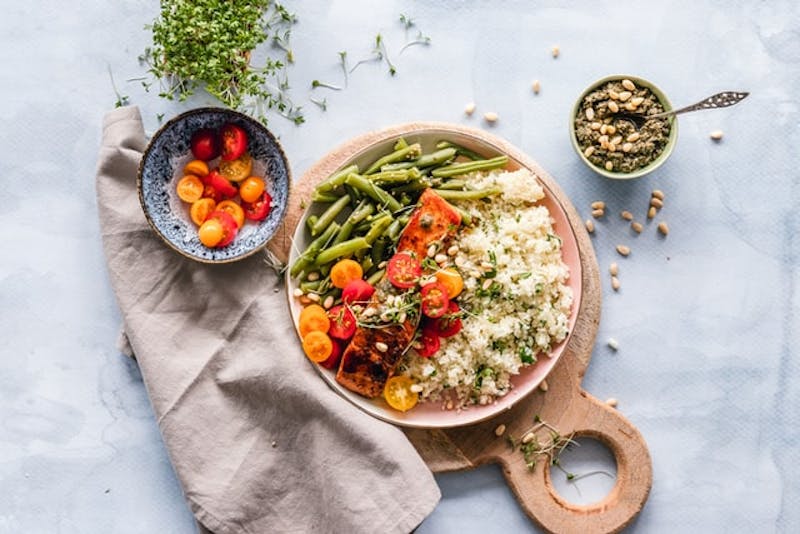
Counting calories is one of the most common suggestions when starting a weight loss plan. But is it the best way to tackle your weight loss goals?
We’ve all heard that if you want to lose weight you have to “eat less and exercise more”.
And there are reasons for that—it’s been proven in many studies that calories play a crucial role in weight loss and weight gain.
One way it’s been shown is in “overfeeding studies”. These are studies where participants eat more calories than they burn and the researchers track their weight over time. The result of these studies is consistent weight gain.
There are also many studies that show the impact of cutting calories on weight loss. One study even shows that when a diet plan includes counting calories, more weight loss occurs compared with those who don’t count calories.
Reducing calorie intake is one of the first logical steps to take when you want to lose weight. This is why many people track calories when they want to lose weight. Some people will keep a food diary and manually tally up their calories each day. Others will use apps that help them track their foods digitally. However you decide to count calories, the point is to track and count every single calorie you eat in a day. Even if it’s just one cookie or a handful of grapes.
Calorie counting is only successful when you have a truly accurate measure of how much you really it. As a result, counting calories is not the easy catch-all it sounds like.
When it comes to starting a diet, there is more nuance in what it takes to make counting calories work.
Why counting calories is harder than it sounds
While counting calories sounds simple, it isn’t always so easy in practice.
It’s easy to undercount, as many people do. One study found that Americans tend to underestimate the number of calories in meals and snacks. Without accurate calorie information, guesses tend to be under the actual calorie amount by anywhere from 110 to 165 calories on average.
Not only do we tend to underestimate our calories, but it’s also easy to forget to track a meal or a snack, and then have to guess later on what the calorie count was. Plus, it adds extra steps to your meal prep process by measuring and weighing out specific amounts of foods so you hit your calorie targets.
All of these factors combined together make calorie counting harder than it sounds. So, while yes, it is fundamentally true that a calorie deficit is necessary to lose weight, there are other factors at play that make it more complex.
The method also doesn’t address the importance of another factor—the quality of the food you eat.
Quantity vs quality of the food you eat
The positive about using calorie counting as your method for dieting is that it doesn’t require you to strictly cut out certain types of foods.
But, if you want to see results and experience positive health effects, then the quality of your calories matters.
While you could technically eat ice cream, chips, and other highly processed foods every day and stay under your set calories and lose weight, what are the long-term impacts of that?
When your diet is high in processed foods, you are at a higher risk of:
- Heart disease
- Cancer
- Diabetes
- Inflammation
So while a diet that helps you track calories is part of the equation, it’s also important to have a diet that fulfills your nutritional needs with high-quality calories.
This is why many people include tracking macronutrients in their calorie-counting diets.
What are macronutrients?
Macronutrients are types of food that are needed in high quantities in our diets. The three types of macronutrients are proteins, fats, and carbohydrates. Proteins are the building blocks of muscle and also help in hormone production. Meanwhile, carbohydrates and fats are used for energy.
And with the right balance of macronutrients, you’re more likely to get enough of the vitamins, minerals, and dietary fiber you need as well.
To have a balanced diet it’s important to have a healthy mix of:
- Fresh fruits and veggies
- Lean protein sources
- Healthy fats like avocado, olive oil, nuts, and seeds
- Complex carbs
In addition to being more nutritionally dense than highly processed foods, choosing fresh, whole foods are also more satisfying, or satiating.
Food is satiating if it leaves you feeling properly full and satisfied. If food is filling, it tends to be:
- High in protein, as it’s the most filling macronutrient
- High in fiber which provides bulk and helps you feel full longer (for example, eating an apple that has a lot of fiber will keep you fuller longer than a few cookies)
When you want to lose weight, it’s helpful to choose these types of food so you get the most nutritional value and have an easier time staying within your calorie limit each day.
Weight loss is complex
While on the surface weight loss seems simple (burn more calories than you eat), it’s a bit more complex than that.
Many of your diet habits are ingrained from a young age. Emotional and psychological associations with food influence the type of food you crave. And those associations influence how easy it is to stick to a diet. On top of that, making a conscious effort to count every calorie can get time-consuming. Even when you use an app you still have to weigh out your food and remember to input your meals. Like any new habit, it’s hard to stick to and can add an extra barrier when simply trying to eat healthier can be hard enough.
That’s why simply trying to eat less is a challenge for many people. Instead, they need extra support and help to learn new diet and lifestyle habits better for long-term health.
When you have support to achieve your weight loss goals, you are more likely to achieve them —and get to your goal weight faster. Instead of wasting time jumping from plan to plan without success, you can trust that you’ll get the right weight loss plan to see results.
At Valley Medical Weight Loss, we help make tracking calories easier and we help you get a nutritious meal plan that’s easy to follow. And with each of our weight loss plans, you get weekly check-ins and support from our doctors.
For your first consultation, visit your closest Valley Medical Weight Loss today. There’s no appointment necessary!

